This article is a part of Medicine Stories, an exclusive series for Intercontinental Cry made possible by a grant from the Elna Vesara Ostern Fund. This is the second story in a series about the traditional medicine of the Wixárika (Huichol) Peoples of Western Mexico. See Part 2, Wixárika medicine under siege.
THE MEDICINE IS TEACHER, MASTER; IT IS THE BLUE DEER, THE ONE WHO DETERMINES FROM THE FOUR DIRECTIONS WHERE THE SACRED SONG IS SUMMONED, WHERE HE TEACHES US TO SPEAK, HOW TO HEAL, HOW TO MAKE CURES, AND THAT IS WHY THIS IS VERY SACRED. THROUGH THE MESSAGES OF THE MEDICINE, WE CURE OURSELVES IN THE CEREMONY. THERE WE SEE THE NEWS AND THE ANCESTRAL MESSAGES, AND WE SEE HOW WE HAVE TO ACT.
MARA’AKAME JUAN JOSÉ KATIRA RAMÍREZ, “UXAMUIRE”
LA LAGUNA, SAN ANDRES COHAMIATA, JALISCO, MEXICO —The sun is setting as we arrive in La Laguna. It’s been a long day of travel and an even longer week for the Ramírez family, many of whom have just completed their pilgrimage to Wirikuta, the faraway desert where they find their sacred medicine and the spiritual guidance that helps them set the course for their lives.
It’s a long and rugged trek through the desert, with stops along the way to leave offerings at the sacred springs and other sites that it is the Wixárika duty to care for – just as it is in all five of the principal sacred sites representing the five directions – North, South, East, West and Center. And now that they are home, one would think the time had come for rest. But for José and his group, the work has just begun.
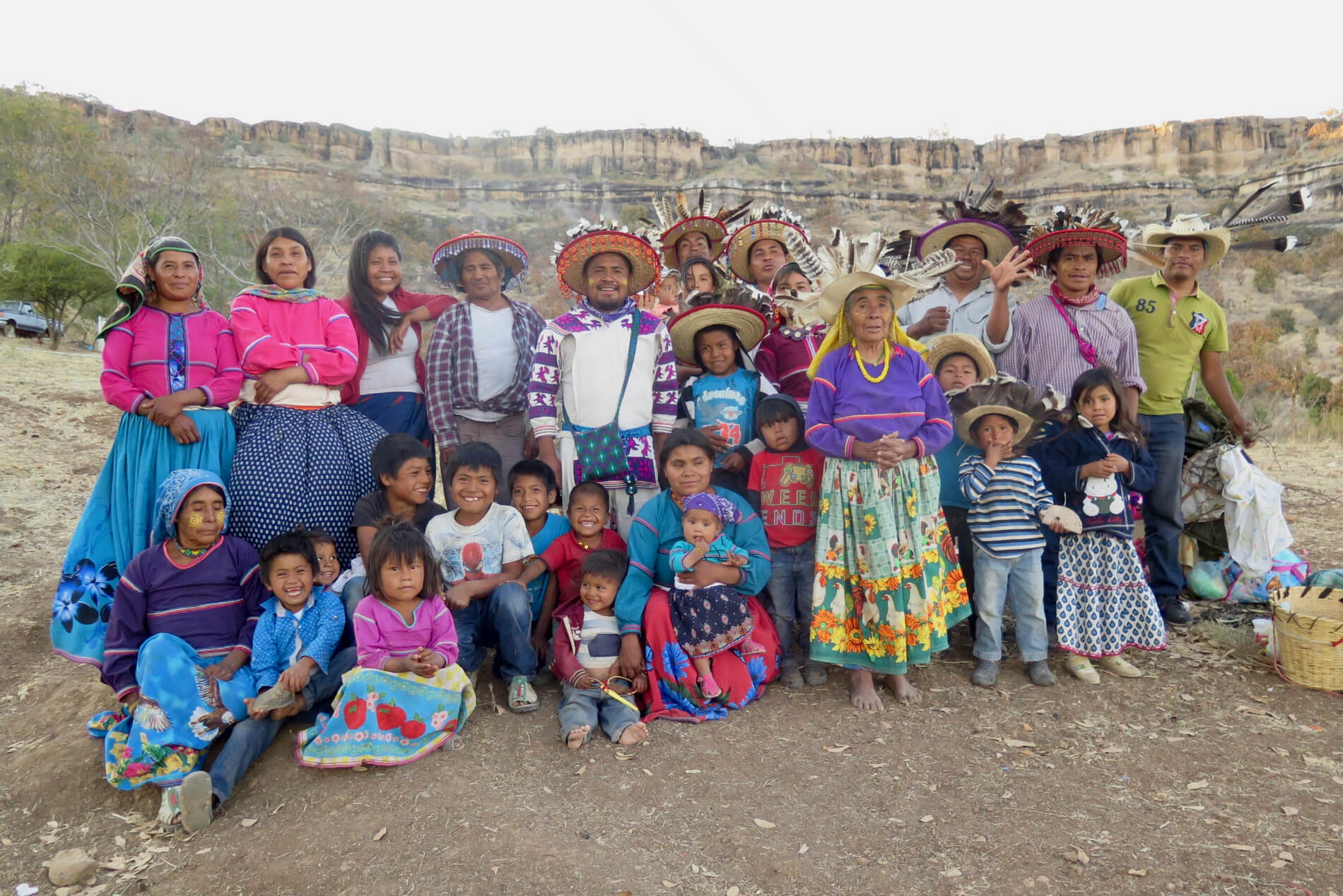
Ramírez family members line up in front of Laguna Seca’s dramatic cliffs for a family portrait. Photo: Tracy Barnett
I had dreamed for years of coming to this place, a rustic Wixárika, or Huichol, village high in the Western Sierra Madre, where my friends José and his sons Enrique and Clemente live in the traditional way with their families and neighbors. But it’s no small commitment to come here, and it wasn’t until now, when I was invited to write a piece on the traditional medicine of the Wixárika people, that I finally was able to make a space.
I came with the idea of learning about the assortment of herbal plants that make up the traditional Wixárika pharmacopoeia. But things don’t always go according to plan in the Sierra, and this was no exception. This was the height of one of the most important ceremonies of the year, and all hands were occupied in the traditional tasks required at this time. And it was also the dry season, when most of the herbal medicines had dried up.
But as it turned out, it didn’t matter at all. The subject at hand was the Master Medicine: Hikuri, or peyote, and there was so much to learn.
José showed me to his house and offered me his bed – he would be spending the night with his wife, Tulama, and all the family by the ceremonial fire. I put my things on the bed and asked to accompany him.
We found the group gathered around Tatewari, Grandfather Fire, many wearing their traditional dress, embroidered with their sacred symbols, and their plumed hats that serve as antennae, connecting them with the spirits. We presented ourselves to the fire.
There next to the fire, coordinating the services, were the authorities – I was surprised to see they were boys of around 10 or 11.
“We make the children our authorities so that they can take responsibility and learn the traditions,” José told me.

Cristofer Ramírez, son of Clemente, is already a veteran on the Wirikuta pilgrimage at the age of 5, and he wears his uxa face paint and ceremonial hat with pride. Photo: Tracy Barnett
On one side of the fire were the hand-woven bags of the pilgrims filled with their offerings; there was also a gourd filled with water from the sacred springs, and another on the other side of the fire, each with a muvieri, or feathered wand. I was to bless myself with the water and say my prayers, the boys instructed me. I anointed myself with the holy water and gave thanks to be there in the flickering golden light, under the stars in this valley of the gods, surrounded by the energy of this family of mara’akate[1]
The series of ceremonies I was privileged to witness were all a part of an intricate system of practices designed by the ancestors to nurture a relationship with the forces of nature, and to maintain an equilibrium with those forces. Indeed, the Wixárika people who choose to follow the traditional path dedicate their lives to maintaining these relationships, and they see their role as the keepers of that delicate balance – not just for their family, not just for their village, but for the entire world. And to understand traditional Wixárika medicine was to understand the deep work required to maintain that balance.
Communing with the gods
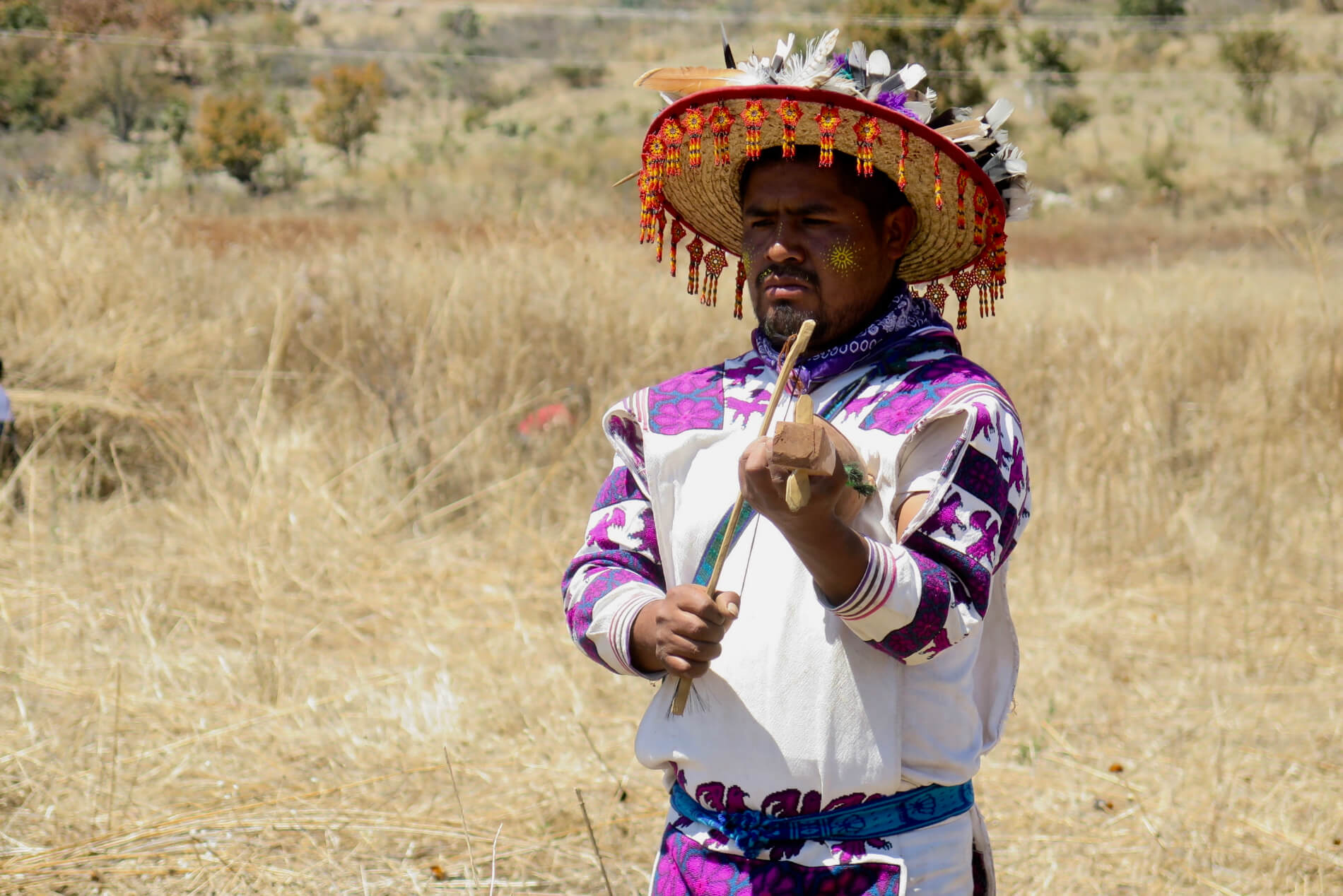
Clemente Ramirez and his brother Enrique have followed their father’s tradition as mara’akames and traditional musicians. Here Clemente plays to the elements as his relatives prepare the cohamil for planting. Photo: Tracy Barnett
That night was just the beginning of a marathon of ceremony, each ritual in its own way designed to reconnect and pay homage to the essences of life. Nights were dedicated to caring for Tatewari; that’s when José and his mara’akame sons, Enrique and Clemente, would pull out their Wixárika xaweri, or violins, and play the sometimes upbeat, sometimes otherworldly melodies telling the stories of the origins of the universe. The pilgrims would dance, feet beating a rhythm in unison around the fire, a staccato message to the Mother that all was well.
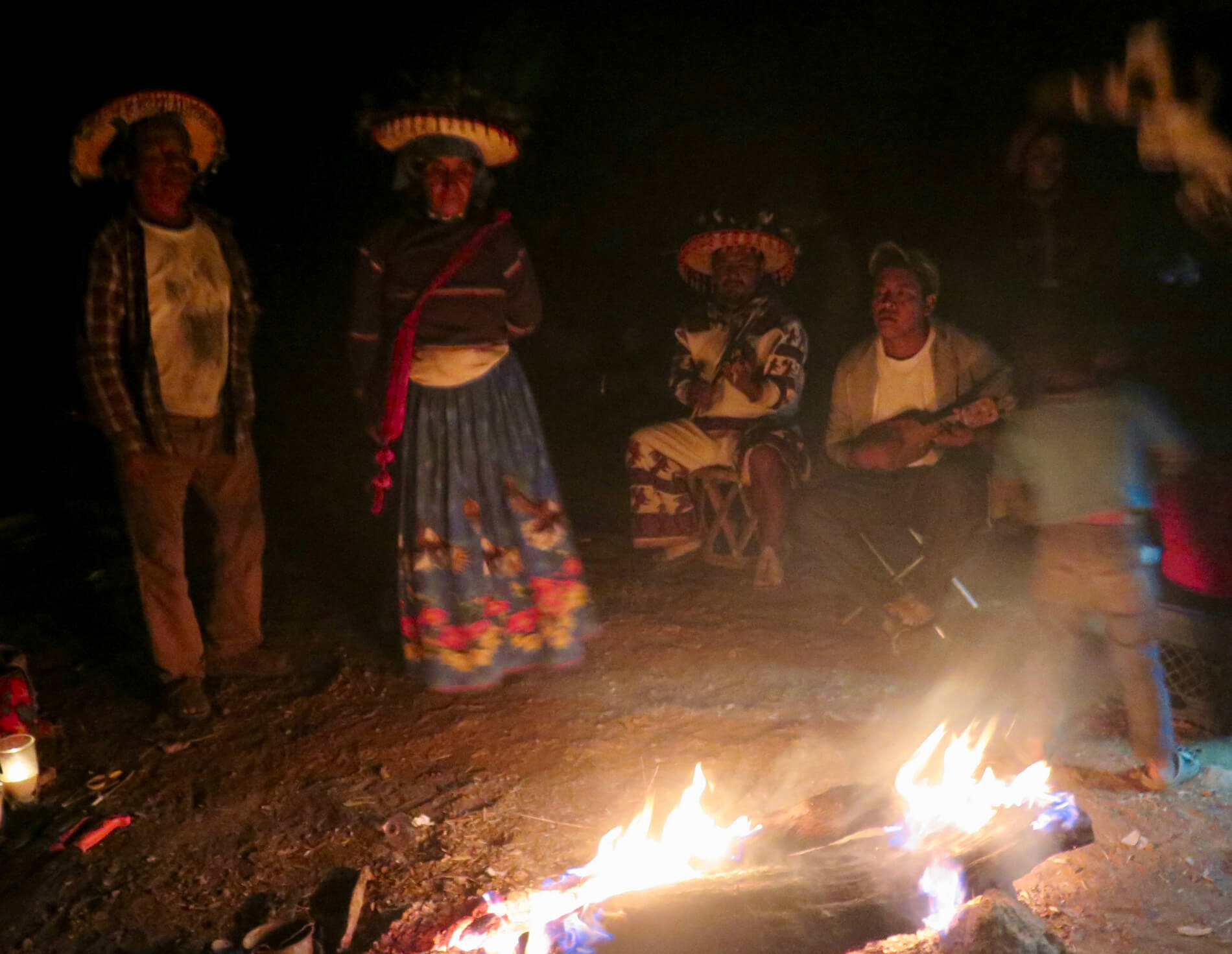
Nighttimes during ceremony are spent around Tatewari, Abuelo Fuego, in traditional dance and music replicating the creation stories and reflecting in communion with their sacred medicine. Photo: Tracy Barnett
Daytime was dedicated to a different sort of ceremony. In the morning, Tulama pulled a root from the desert out of her bag and began the work of grinding it into a bright yellow paint. Soon she was painting sacred designs on the faces of the children, and then José, and then herself; deer, rain, the peyote flower. The root, gathered in Wirikuta, is called uxa (pronounced Urra) and serves to connect the pilgrims with the deities, or the ancestors, or the elements.
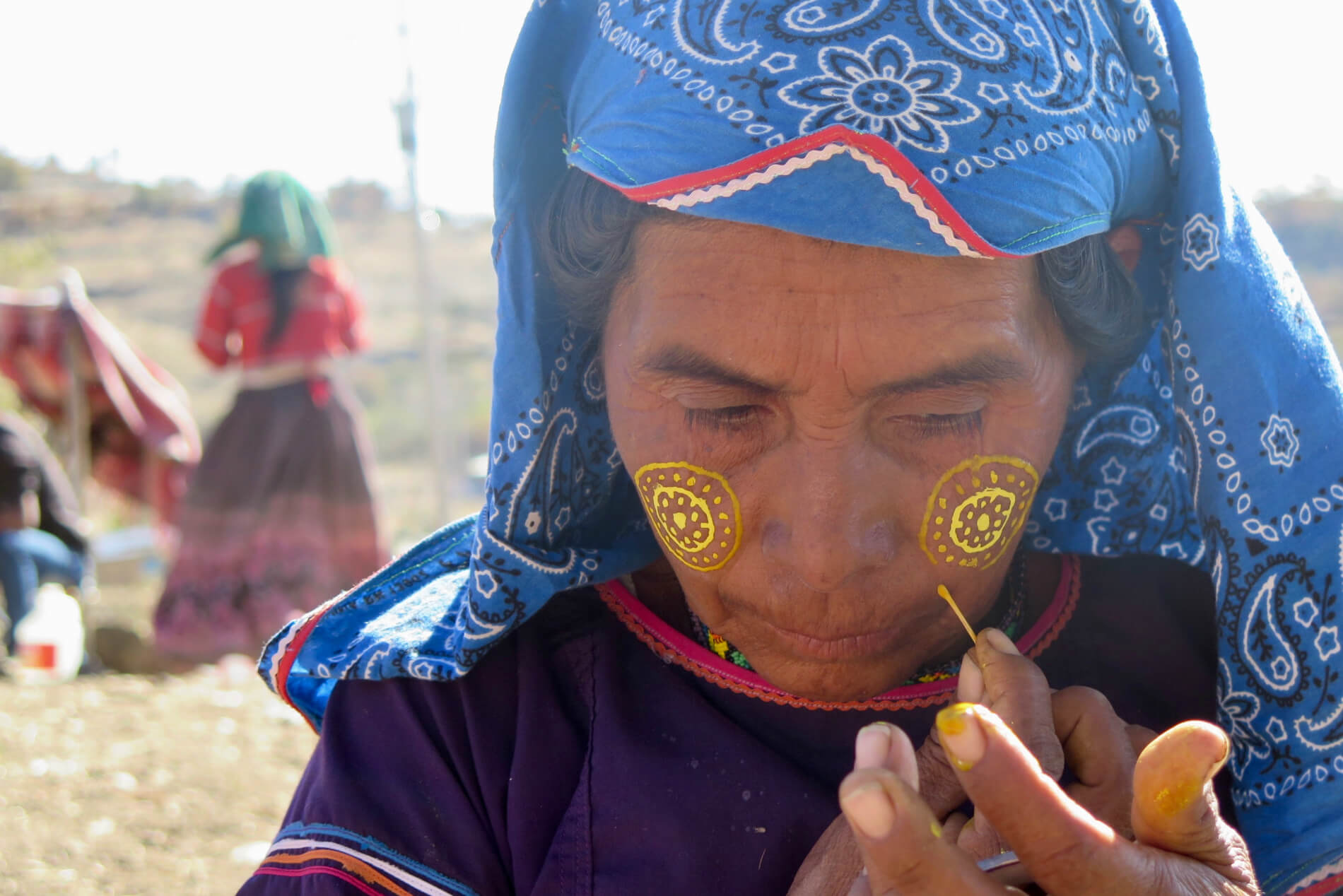
Tulama, José’s wife and also a mara’akame, paints her face with the traditional peyote flower design using uxa, a bright yellow root harvested in the desert of Wirikuta. Photo: Tracy Barnett
“It’s like our radio,” José explained, smiling. “It’s so we can hear the news.” His gesture took in the universe, helping me to understand the news in a far more cosmic way than has been my custom.
Now it was time to set to work – but work, too, was ceremony. Each pilgrim’s coamil, or cornfield, would be attended in turn, with the brush that had grown up being cut away with machetes under a blazing sun. The first one of the day, Artemio’s, was at the bottom of a sheer-sided canyon; I honestly didn’t know how I would do it but with José’s help I made it down in one piece, getting the botanical tour along the way.
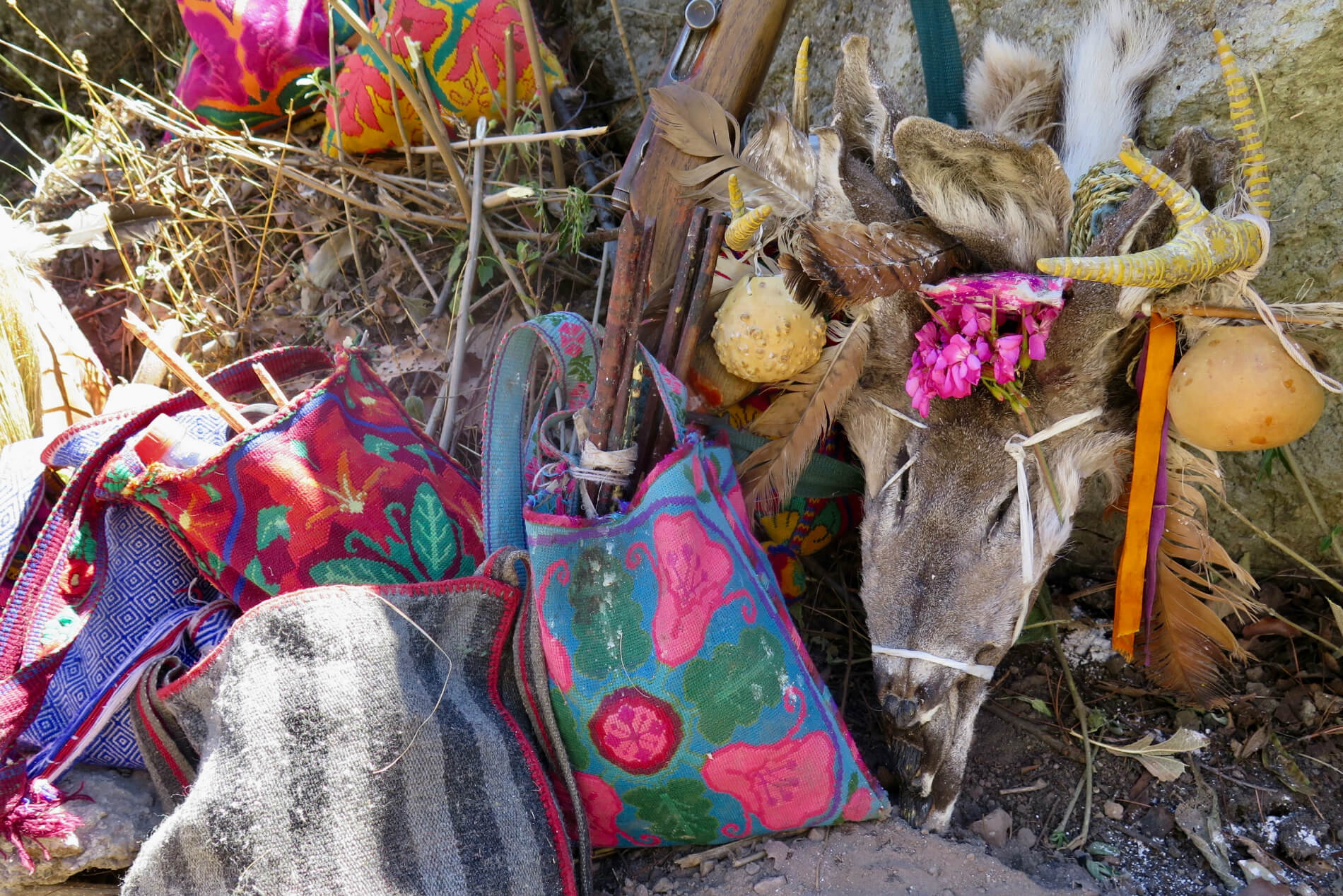
Each pilgrim carries a bag of offerings and sacred objects to each ceremonial site, where the adorned head of the sacred deer serves as the altar’s centerpiece, here at the base of Artemio’s cohamil. Photo: Tracy Barnett
José had been collecting firewood for Tatewari, so by the time we arrived at the coamil, midway down the slope, it was time for the prayers. Clemente was repairing the violin with a piece of wood he’d cut from a nearby limb and was whittling into shape; Enrique was tending to the offerings, and Tulama was cutting the peyote into fresh, thick slices. Adonai, the 11-year-old governor, was cutting oranges to sweeten the bitter medicine.
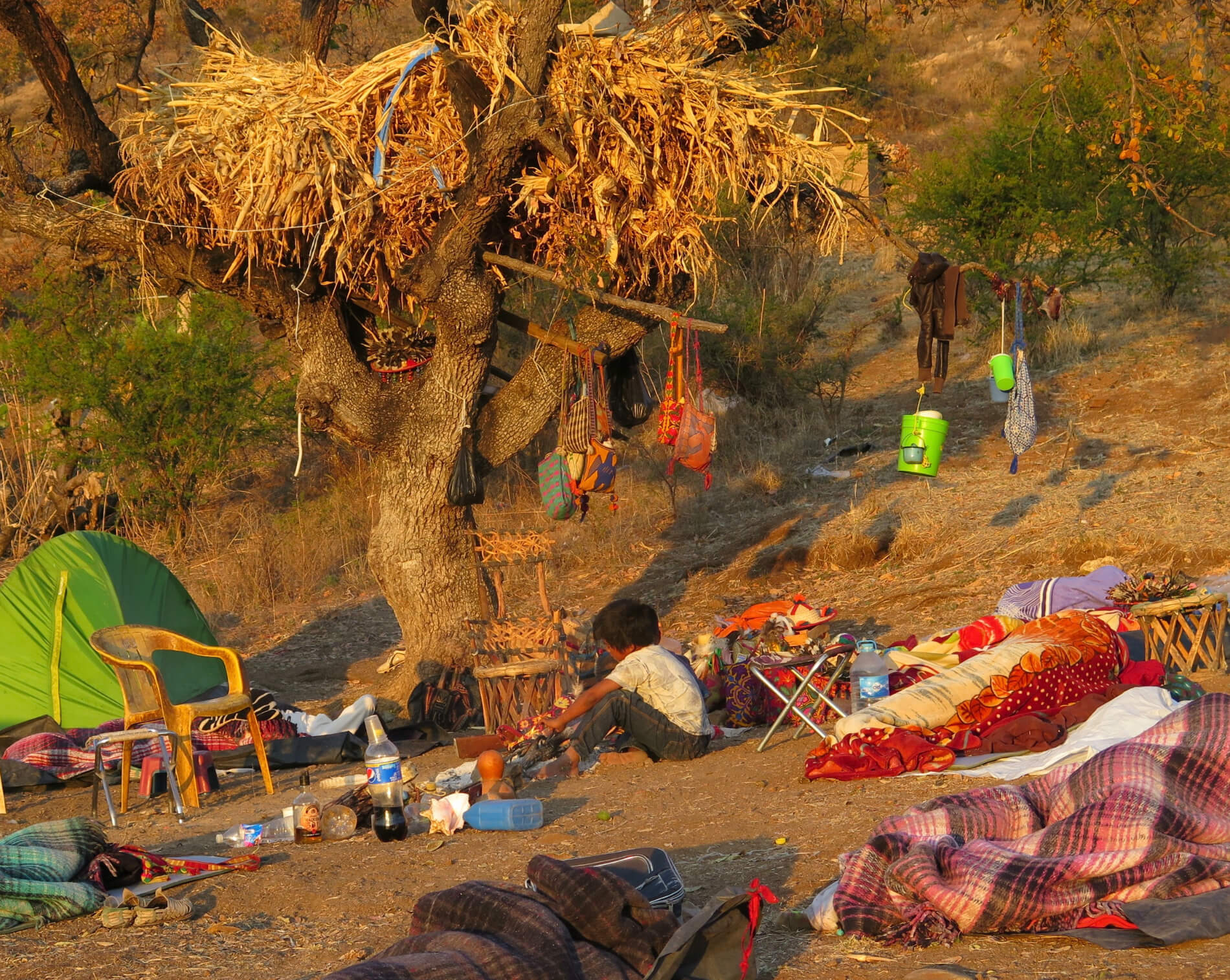
Adonai, the 11-year-old “governor” appointed to preside over this ceremonial period, cares for Tatewari, Grandfather Fire, as the sun rises over his sleeping relatives. Photo: Tracy Barnett
“Eat some,” urged José, noting my fatigue. “It will give you strength.” Seeing the uphill climb that lay ahead, I took him at his word.
My attention turned to the makeshift altar that had been placed at the base of the sloped cornfield: each of the pilgrim’s bag of offerings, with the head of a deer among them, adorned with flowers and feathers and gourds, its antlers painted in an intricate yellow design with uxa. There were the workers’ tools, gathered to receive the blessing: machetes, knives, the rifle one young pilgrim used for hunting.
Little Jonathan wasn’t feeling well, though, so Clemente attended to him under a tree, massaging his stomach deeply for a time. The boy, who along with a number of other children had made the pilgrimage, was suffering a stomach ache from too much exertion, sun, and peyote.
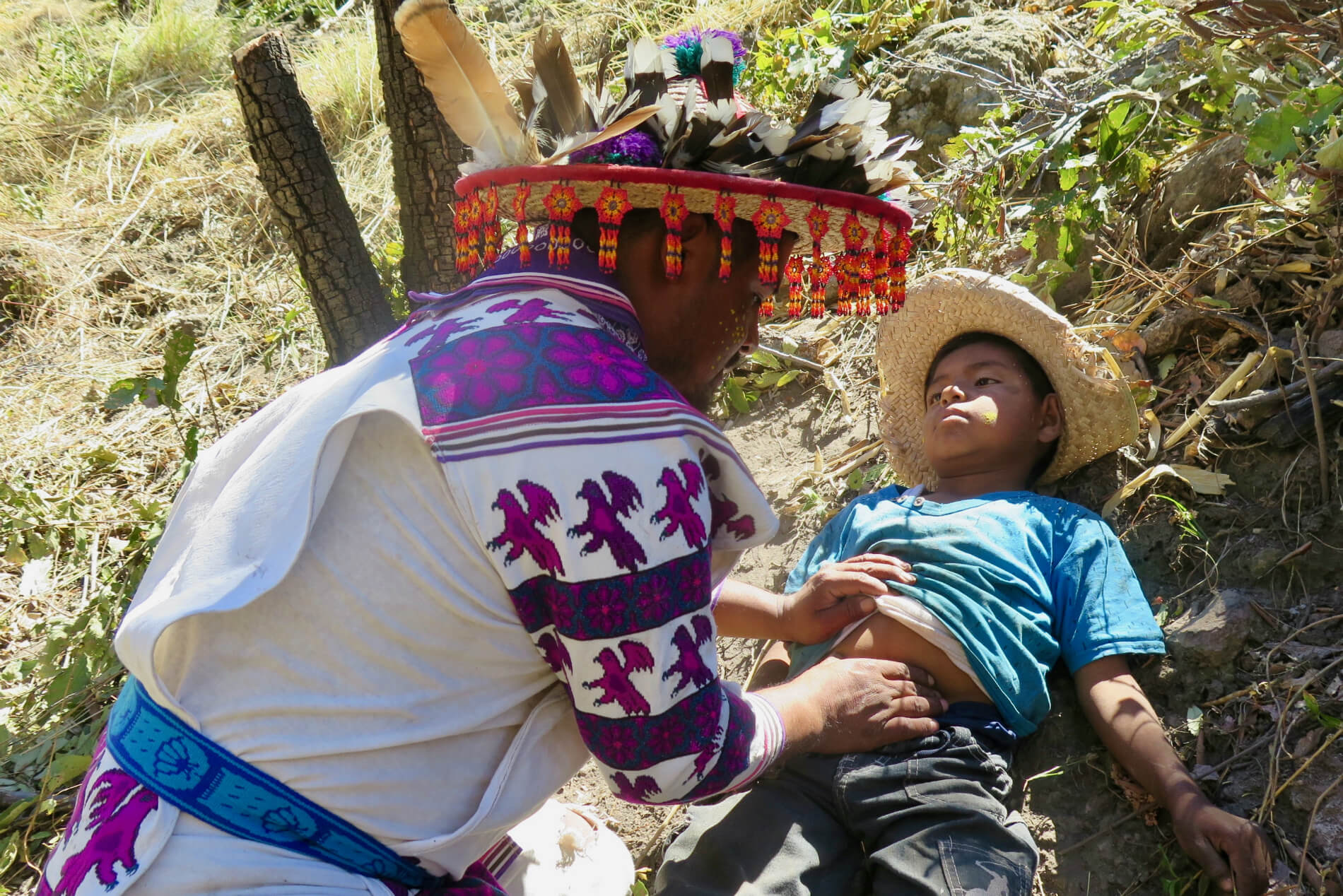
Clemente practices a healing technique on nephew Jonathan, who is suffering from a tummy ache. Photo: Tracy Barnett
Soon the boy was feeling much better, and it was time for prayers. Voices in Wixárika went up in unison, convoking the rain, the sun, the elements. The high-pitched tones of the violin soared up the canyon walls, the music a mixture of medicine and message. Wherever the gods were, I supposed, they must be happy.
José put me at the front of the line for the uphill climb and I tried to soldier my way up with the best of them, but soon I realized I was holding them all back. I invited them to pass me as I stopped on a switchback to catch my breath, surveying the Grand Canyon-like horizon opening to the south and a climb ahead that far exceeded my level of condition.
“No, it’s better that you go first – otherwise it will be harder for you,” José said kindly, and his compatriots apparently agreed.
I gave thanks for the medicine and climbed on.
* * *
THE MEDICINE HELPS THE HEALING OF THE PLANET THROUGH THE SONG, IN EACH SEASON, IN EACH EQUINOX. THAT IS WHY WE HAVE SOME CLASHES IN HUMANITY WHEN THERE IS AN EQUINOX. WE MEET TO RENEW THAT SONG… IF WE HEAL OURSELVES, WE ARE ALSO HEALING THE PLANET. BECAUSE WHEN YOU FEEL THAT A MEMBER OF THE FAMILY IS SICK, YOU ALSO FEEL SICK, YOU WORRY, AND WHEN WE ARE HEALTHY, THE CREATOR IS HEALTHY AND HAPPY.
THE PLANET IS SICK BECAUSE WE ARE MAKING IT SICK, THERE IS MENTAL IMBALANCE, THERE IS ENERGY MADNESS, WE ARE TALKING NONSENSE, WE ARE TALKING ABOUT PURE POLITICS. AND THE PLANET FEELS THE PAIN, BECAUSE OUR PLANET CARES FOR US ALL, IT LOVES US ALL.–MARA’AKAME JOSÉ RAMÍREZ
“A mara’akame does not work only on a single person, he is in contact with everything and he works in that way,” explained Carlos Chávez, who has worked with the Wixarika people in a variety of capacities since the 1980s, when as a naturopathic healer he established an herbal clinic in San Andrés Cohamiata. In that role he collaborated with many mara’akate and observed their work, as priests and as healers. “I can tell you that there really is a knowledge, a deep, true wisdom in Wixárika traditional medicine, which is very, very important, because there are no clear limits between healing a person and curing nature. Because many times they tell you, “It’s just that there is a disease,” and then that’s why you’re like that, because there’s a disease, so you have to heal nature, you have to cure what’s wrong in the universe and then you can concentrate on yourself, to heal yourself. A mara’akame does not work only on a single person; he is in contact with everything and he works in that way.”
What Chávez came to understand was that the mara’akame is something more than the healer.
“The mara’akame is something that gives you your energy, your ability; you connect with the healing energy of the world and the universe. The mara’akame is not something you learn, like medical surgeon. No, the mara’akame is something that is. It is not given to everyone. But if you walk the road, you will receive it.”
Walking the road is no simple matter. Teresa Rivas, founder of the Center for Indigenous and Traditional Medicine in Guadalajara, has accompanied the Wixárika on that path for two and a half decades now, and it has become a way of life. Rivas, who comes from the south of Mexico, is a healer of Maya heritage, so she had to learn as an adult, and it was a long, hard road.

Teresa Rivas, director of the Center for Indigenous and Traditional Medicine in Guadalajara, is of Maya descent, and has practiced the Wixárika tradition for 26 years. Photo: Tracy Barnett
“Carrying the offerings to the sacred sites is a task for the whole Wixárika race,” she said. “Anyone else can go and take or not take an offering, give a coin or a piece of chocolate at their temple, but a Wixárika has to make offerings in the sacred places, on that depends the health of his people, whether there is rain, whether there is peace, food, health for their animals.”
Four years into her five-year commitment of pilgrimage, taking offerings to the sacred sites, fasting from certain foods and intimate relations. And one blessed day, in the heart of the sacred desert of Wirikuta, along with her compadre José Ramírez and her teacher, Mara’akame Julio, she received the mara’akame. As she recalls it, it was at the same time José received his, which is why they share a special bond. “It’s like a type of complicity – a special understanding that we share,” she said.
Her gift for healing later translated into the founding of the Center for Indigenous and Traditional Medicine, which includes a school and a ceremonial center that transmits traditional healing to thousands.
To her, the essence of illness from an indigenous perspective – including that of the Wixárika – can be summed up in this way: “Disease is born as a seed, of a wrong attitude towards life. A mistaken mental and emotional attitude and wrong behavior sow the disease, and failure to fulfill our existential purpose. We all have a mission in life, and to not live under that vision makes us sick.”
Around the same time, after a number of pilgrimages and working with the mara’akate doing healing work in the Sierra, Chávez observed phenomena that left a profound impression. His capacity to heal was always intuitive, but it became more so.
“There is something intuitive, there is a certain moment when you see the person and you feel what is happening, and then you act… You are going to give a massage or a tea, but you start working on what you are seeing. And you feel that it’s going to be just three leaves, and I’m going to give you this amount of this other thing and I’m going to give it warm. Those things happen.
“But then when I was with them that was what they made me see, that it was something that was there, the mara’akame, that they are using, and even many times they are healing from a distance. That is why they say that they are always taking care of you. They are watching over you, and very strongly… If you are an agrarian authority, you have a mara’akame in charge, who is taking care of you, all the time. He has to be fasting, he has to make sacrifices, he has to go places, and all the time they are dreaming.
And when something happens to someone, the authorities go to the mara’akame in charge to ask him, What happened? You were taking care of him. Then he has to explain, why he had a bad time, if he fell into the ravine, etc.
“When the mara’akame tells them, “you have to go to Wirikuta or you have to go to leave an offering,” they do it, because he is the one who is taking care of them. Then the mara’akame heals, but a broader thing than just the individual or very particular situations.
“Although they also can become that way, too—very exact. He touches in your heart the precise point of the moment when your mind or your heart got damaged or something happened to you and you realize that he is looking at you, and you feel transparent, and he is telling you—there are moments when a thought is just being born, and he’s already saying, ‘No, wait, it’s not like that.’ It is an encounter of consciousness, of the exchange of the symbols of energy, so intimate, deep, dynamic, constant, strong.
“That’s true, that I know they do. Not everyone sees it, they don’t always show it, but it is something that happens a lot, constantly in the traditional world, deeply traditional. There it happens all the time. But then there are different dimensions of existence and perception. Then suddenly it may be that if you are only looking for words and reasoning, they will tell you words and reasoning, because that is what you want to find. But in reality the deep, sacred work to which many Wixáritari ommit themselves is a real contact with very original energies of the universe, very essential.”
I went to La Laguna in search of words and reasoning, and that is what I found. José did his best to take me to the places where the wild healing plants grow, even though it was deep in the dry season and there wasn’t much to be found. He took me to the dried-up herbal medicine garden near the clinic that nobody really has time to tend.
Upon my urging he took time between ceremonies and gathering firewood and tending to the cattle and clearing cornfields, and he healed an ailing grandmother – one of the pilgrims whose body ached from head to toe, probably from the tremendous exertion of pilgrimage. I had to remind him three times, though – so immersed was he in the work – and he had left the herbs behind that he had found for her. At that moment, however, he looked down, and there it was – a plant with thorny leaves, called San Antonio.
He grabbed a bunch and headed back to Tatewari, where the grandmother lay moaning. I scrambled to keep up.
“Here,” he instructed me, grabbing a bowl and pouring water into it. “Take these plants and scrub them together until they produce a soapy liquid. Then apply that in the places where she has pain.”
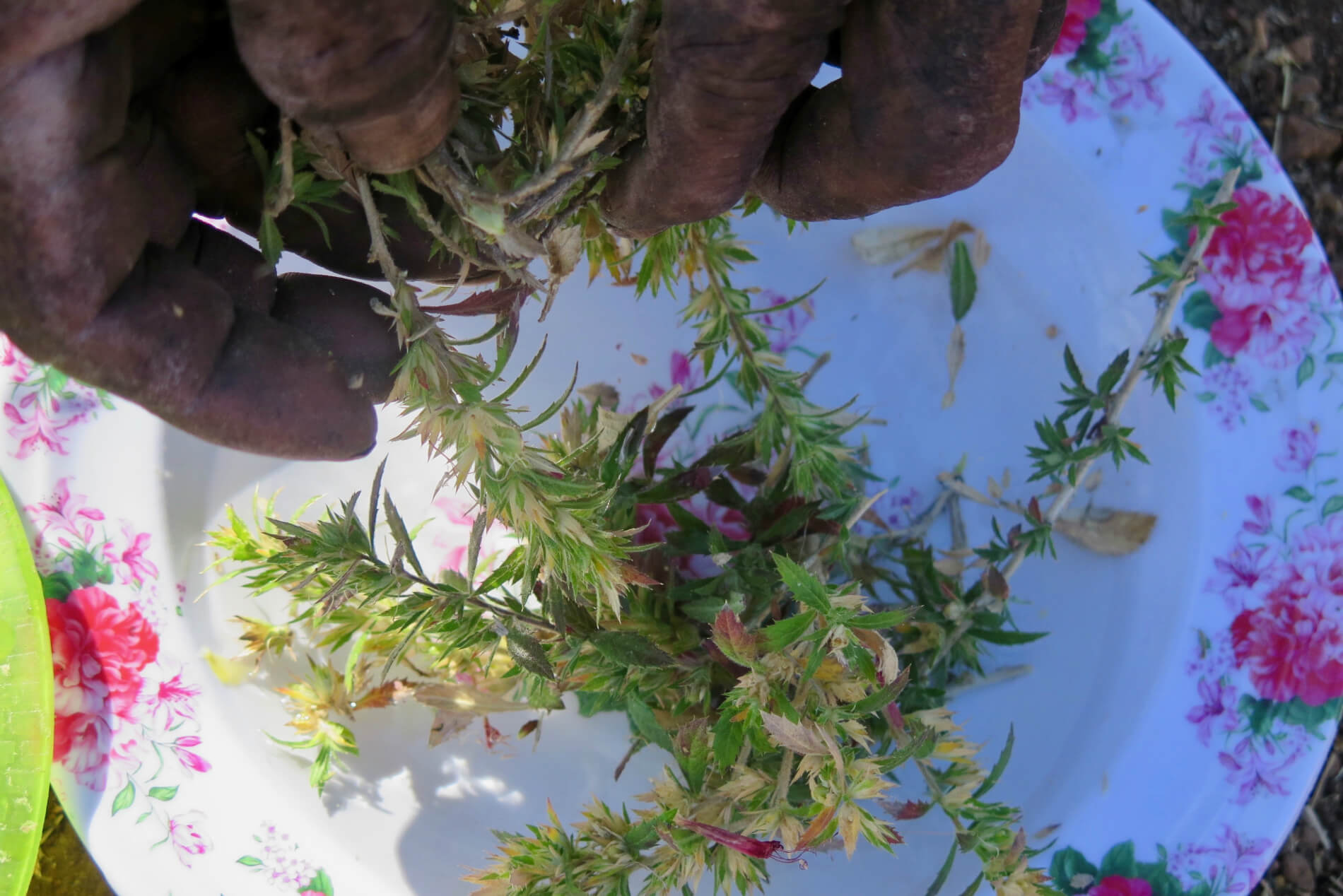
José places the “San Antonio” herb, used in treating aches and pains, into a bowl of water as he prepares for the treatment of Grandmother María. Photo: Tracy Barnett
I tried, but the leaves punctured my soft hands. José cast about looking for a stone or a soda bottle that I could use to crush the leaves, when the grandmother came to and gestured for me to hand them to her. Her rough brown hands quickly extracted the soapy, greenish medicine.
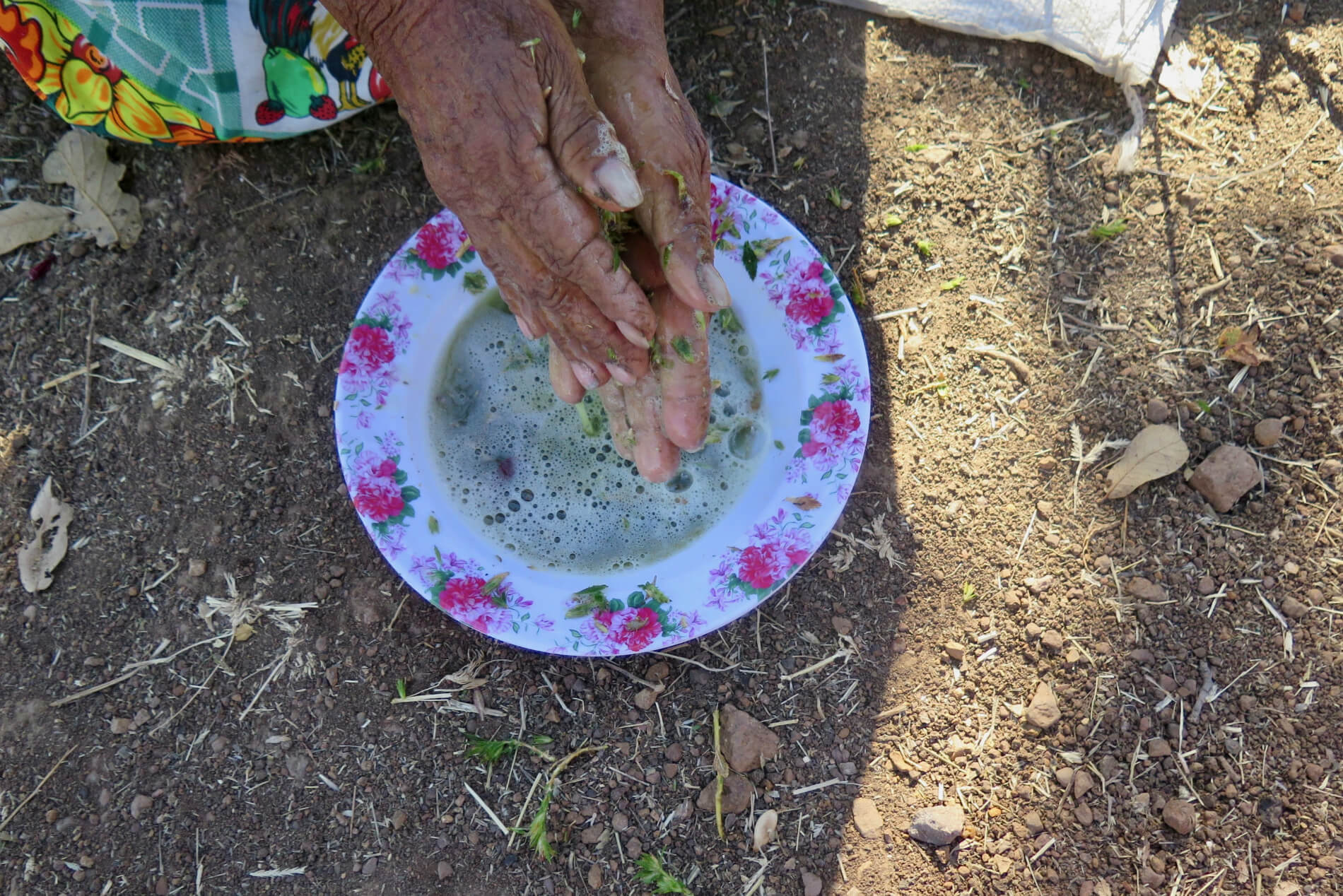
Photo: Tracy Barnett
“Ah, see? The abuela knows how to use the medicine,” said José, handing me the bowl and about to head back to the cornfield when I stopped him.
“Wait,” I said. “Aren’t you going to do a healing with the muviere?”
I’d seen this kind of healing before, with the feathered wands, and it fascinated me. José stopped in his tracks. It took an effort to shift gears from his forward momentum but he did it. He went to the fire and reached into his colorful bag of offerings and took out the rectangular basketlike takuatsi, the handwoven box that mara’akate use to guard their healing tools. He pulled out his muvieri and approached the grandmother.
“Where does it hurt?” he asked her, now genuinely tuning in.
“Everywhere,” she whimpered, holding her head, touching her belly, reaching down to uncover her feet.
José circled her head with the wand repeatedly, then her body. He held it to her chest and listened carefully. Then he began to suck on the tip of the wand, the feather end pressed against her chest. He took the wand and stood, cleaning it and throwing whatever he had found into the fire.
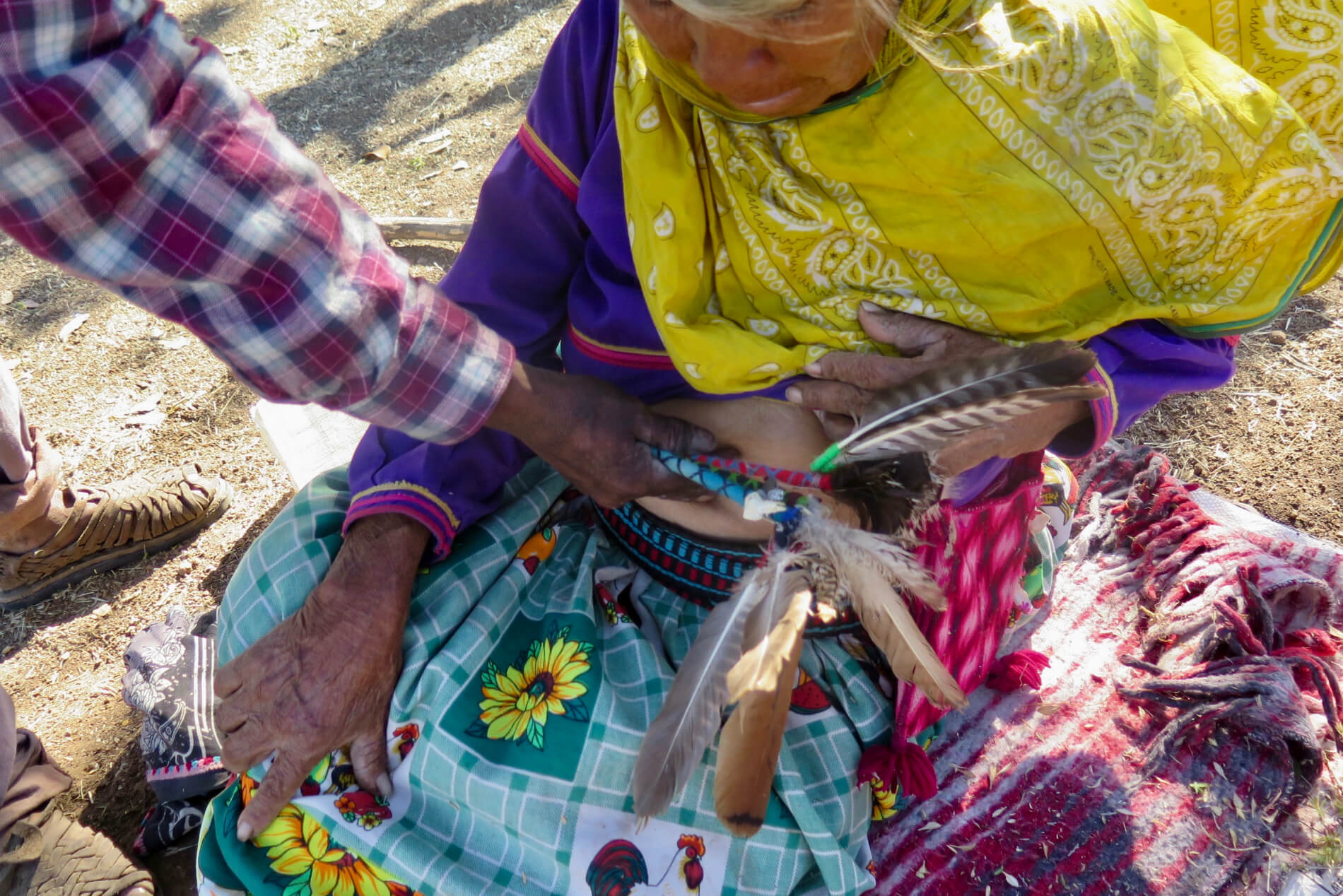
José uses the muvieri to help sense the origin of the pain and remove it. Photo: Tracy Barnett
He repeated the procedure several times, until the sound of a caracol reached us from the direction of the coamil. “I have to go now,” he said to the grandmother. “Teresa is going to take care of you now. And you will be better.”
So there in front of Tatewari and all the spirits I took the bowl and summoned my best healing powers. María was her name, and we bonded over the soapy green liquid, massaged into her from head to toe. I left her on the camping mat that José had handed me before he rushed off, covered with a blanket. When I saw her at dinnertime, she was smiling. And by morning, she was instructing Adonai in the finer points of stuffing the skin of a squirrel he had hunted.
The lesson I took away in my brief time in La Laguna was that human pain is not the top priority, at least not during the ceremonial times. The priority is the healing of the world, so that all can be well: the rain, the crops, the climate, their families, and all the families in the world, human and non-human. I saw this in a variety of ways, from the children who ran around oblivious to the mucus streaming from their noses, to the baby with an ear infection who wailed through the night while his mother worked, grinding corn in a hand grinder and stirring an enormous pot of ceremonial tejuino, or fermented corn drink. I lent a hand for an hour or two so she could tend to the baby, and her aunt helped as well; but most of the women were pilgrims, and their presence was requested at the ceremonial fire. By midnight, I could do no more, and collapsed, by now oblivious to the baby’s cries.

Carmela works through the night, stirring the tejuino, a fermented corn drink that will be used in the closing ceremony. Photo: Tracy Barnett
Growing up in this way, I realized, lends itself to one of the strongest capacities of the Wixárika people is their ability to aguantar, or withstand, things that would send an ordinary human to the hospital.
But there is much more to the story, I learned. Because the experts who granted me interviews had gone far beyond words and reasoning in their lived experiences, and they shared many with me.
Often, in the Wixárika worldview, a person’s illness results from their own failure to follow through on certain commitments they have made to the forces of nature – or, in the case of teiwari, or non-Wixarika people, to God or to their own saints, said Angélica Valadez.
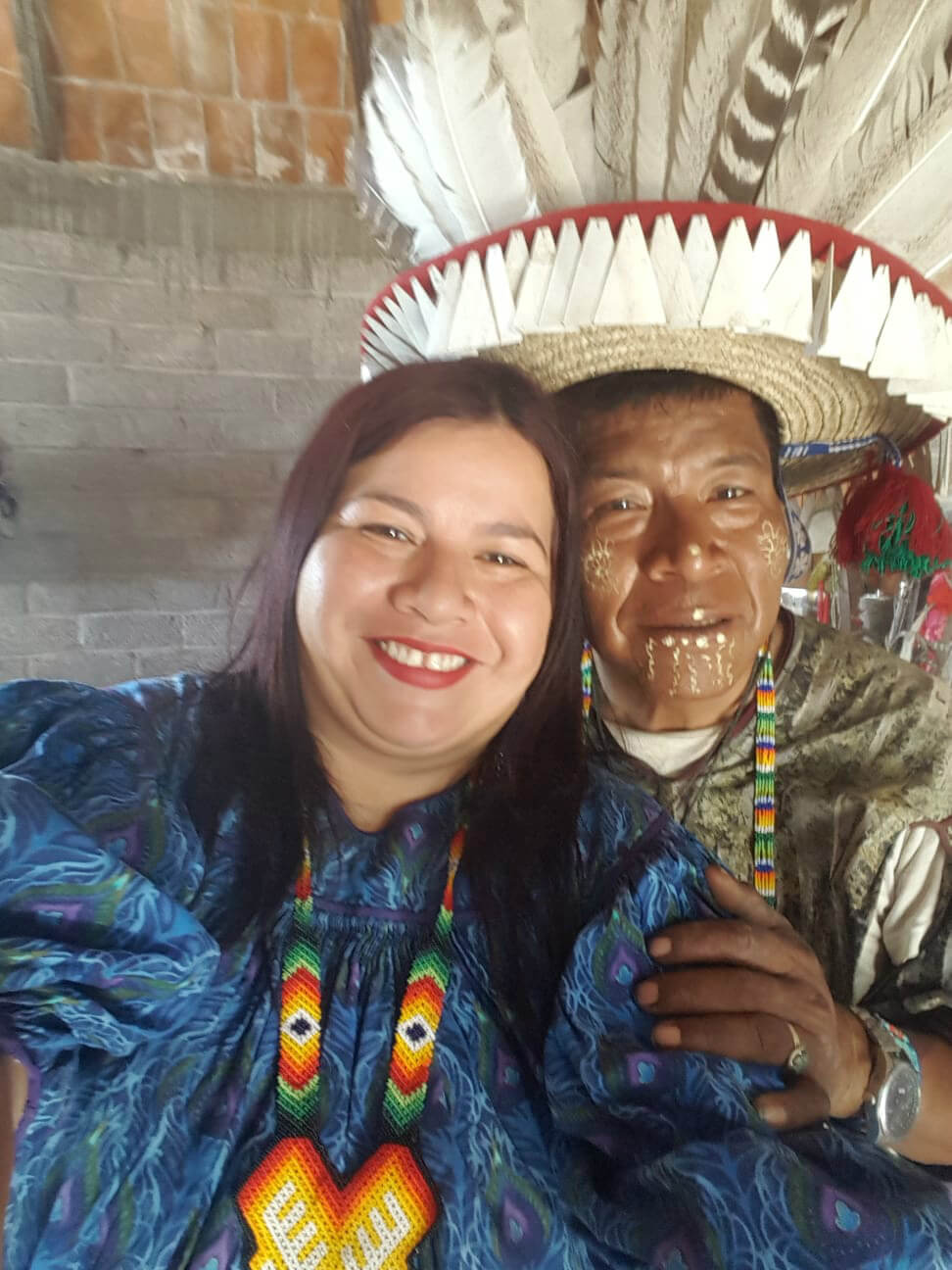
Angélica Valadez, left, with Marakame Marcelino Avila Robles “Yausali,” head of the Ceremonial Center of Santa Catarina-Tapurie. (Photo courtesy Angélica Valadez)
Valadez has the unique perspective of a Huichol-American, born into a family of mara’akate. As such, she began translating for them from the age of around nine, and came to learn many things about her tradition. She’s seen many healings done with the muvierite, and she shared her own interpretation of what’s happening in these encounters.
“(The mara’akame) circles them with feather wands, looks at their hands, looks into their eyes – it’s kind of like a body scan, and the feathers actually represent the power of the sun. So while they’re scanning you with the eagle feathers they’re scanning your body with the rays of the sun – so it’s very deep. And they scan your soul – and they’ll say, ok, you have something going on here, or here.”
She translated frequently for her uncle, a mara’akame named Guadalupe Candelario. One couple came to him unable to conceive children. The mara’akame worked over them with his muvieri and suddenly stopped, looking at the man. “No, no, no, no, no,” he said. “It’s not her that’s the problem. You’re the problem. I don’t know what you’ve got going on but it’s you, not her.”
As it turned out, the man had gotten a vasectomy, and he was just testing the mara’akame.
But Valadez has seen many healings in her years as a translator and student of shamanism. Sometimes it’s a tumor, heart disease, a physical ailment. And sometimes it’s psychological difficulties, like depression, or something deeper.
“When they scan the body with the muvieri they’re able to see energies, and I guess they’re seeing another body, or another level with their scanner – and they’ll say, ‘Here’s a little worm that not supposed to be there.’ And they’ll just suck it out. And sometimes they’ll solidify it, and turn it into something physical; and sometimes they’re just pulling stuff out.”
That explanation put José’s healing with María into perspective.
Sometimes, the work is complimentary to the conventional medical system. “There are diseases that the mara’akame says ‘No, for this disease go to the doctor; this I cannot cure, it’s the doctor’s,’” said Chávez.
Sometimes the mara’akame can heal or detect conditions that are out of reach for the medical system. Sometimes it’s helping a couple to conceive; sometimes it’s detecting a tumor, heart disease or other illness before it’s perceptible to others. Sometimes it’s working in conjunction with conventional medicine to ease the healing process.
“Sometimes it’s good to just clear the spiritual windshield to receive any other medical treatment, or energies, or the right healing light,” said Valadez.
Taken to a deeper level, working with the Wixárika can transform a person’s life. Jorge Camberos Sánchez is one who had that experience as a young man, when through his reading he learned of a culture that went to the desert of San Luis Potosí – Wirikuta – and used the entheogenic cactus known as peyote.

Jorge Camberos, right, with his family. Camberos is founder of Etnoeco, A.C. and a longtime practitioner of herbal medicine. Photo: Tracy Barnett
“In San Luis Potosí I had my first contact with the Huichols and they told me that I should come to the mountains to learn more,” he recalls. He took them up on their invitation. “I came away enchanted, as if by magic, and now I periodically return to the communities.”
His elder brother, Silviano, was a medical doctor who worked closely with the Wixárika. As an herbalist and the founder of Etnoeco A.C., a nonprofit aimed at helping support a community in the Sierra, Jorge has carried on that work after his brother’s death. He feels that the culture has much to give to modern society. In terms of the sacred medicine, he points out that it has shown positive results in the treatment of mental illnesses like depression and anxiety in clinical settings – a factor that Teresa Rivas has found to be true in her work at the Center for Indigenous Medicine.
“Hikuri is capable of tremendous quantum cures,” said Rivas. Unresolved traumas and conflicts create blockages in the brain, and the “master plants” — ayahuasca, mushrooms, hikuri —improve the blood flow to the brain and seek new networks of neural communication. It is a medicine that works at the cerebral level, not only to treat a disease, but all types of malaise. Neural networks are restored and then your perception changes, you see things as they are, and they can be seen clearly, from the spiritual self.”
To Camberos, the opening of Wixárika ceremonies to non-Wixárika people has had profound transformational implications – for individuals, and for the planet.
“The fact that other people can participate in magical religious ceremonies allows us to have a greater contact with nature, to rethink our relationship with the environment,” Camberos said. “We know that much of the crisis of modern society has to do with the loss of values, with the deterioration in our contact with the environment, along with the lack of religious values. Traditional and Huichol medicine can contribute a lot in these aspects of allowing modern society to have a religious approach that can be very healthy — to help put people back into contact with themselves, and to approach aspects of religiosity and spirituality in the context of nature that can be something important for the future of society.”
Next: Wixárika medicine – in particular the peyote, but also the traditional context in which it is used – is under multiple threats, from government boarding schools to U.S.-style junk food to transnational mining companies to intensifying cartel activity.
This article first appeared in Intercontinental Cry. It is available here in Spanish.
entheogens Huichol Peyote sacred plant medicines shamanism Wirikuta Wixarika